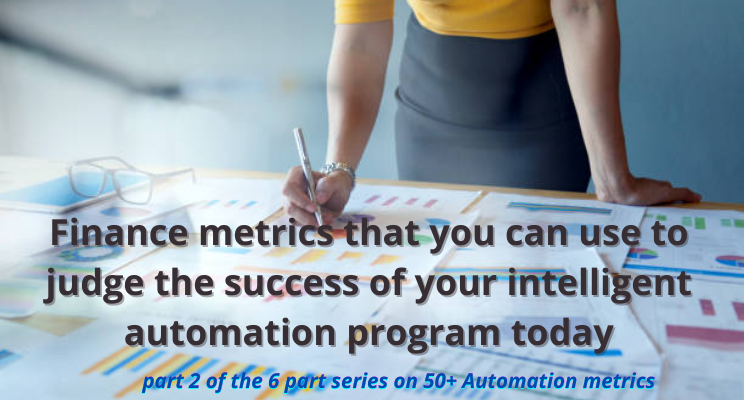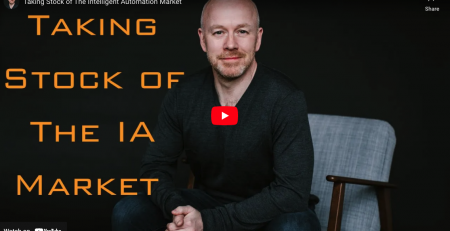Finance Metrics that you can use to judge the success of your intelligent automation program today
In the introduction to this series we looked at why firms need to use KPIs measure automation programs. We now begin our series by discussing our first key set of metrics (i.e. financial metrics).
Lets face it, automation requires investment and one important measure of its success, whether we like it or not, has to be financial metrics.
Financial metrics are amongst the most important of metrics, as an automation program has to pay for itself. Otherwise it is just a cost. A recent article on Debunking Scale and Determining True Automation Value, talks about Automation value and how to measure it.
Financial Metrics
Arguably for some organizations, the most important metric bar non, is a financial metric. Financial metrics are amongst the most important of metrics as an automation program HAS to pay for itself. Otherwise it is just a cost.
“Organisations use RPA to replace slow and error-prone manual processes with scalable and automated digital workflows, and most track financial and operational efficiency. “
Neeraj Satpall, Senior Director AI and Automation Strategist
There are a multitude of financial metrics that can be used to run an automation program but one matters more than most (i.e. net cash or revenue generation).
Vendors have argued that automation programs can pay for themselves within 6 months. Many organizations have found this not to be the case, leaving automation COEs to struggle to justify any investment in automation.
It is highly recommended that you engage your CFO, or a member of your finance team, to assist validate your RPA | IA business case. That way you can be more certain of the returns and costs of your entire RPA | IA program.
“The first step of the RPA and IA journey, is to create a strong business case. “
Konstantinos Vogiatzakis, Director, Process Excellence and Automation
The role of the CFO has evolved from being just responsible for the Financial Function to being a strategic advisor to the business. “The simple truth is that the CFO is now a primary decision maker, thought leader and voice of reason,” according to the Grant Thornton report. FTE reduction as a metric has become passé as organizations graduate to derivative metrics or hard cash/savings metrics.
For example,
- Hard $ savings or actual money saved i.e. a reduction in annual operating expense that can be tracked back the P&L. For example, the annual overtime bill is reduced; FTE exit the firm and are not replaced; a third party call overflow service is ended; creating a Robotic Process Centre of Excellence to complete high volume, repeatable work and ending an annual outsource contract; etc. then these are considered a hard saving.

Figure 1: Calculating FTE (Full Time Equivalent) Saving from RPA | IA
- New incomes: For example; a Midwest trucking company was able to use automation to capture re-routed truck routes that were not being captured on paper, during winter storms and hence were able to capture lost revenue. Another example includes leveraging ‘digital workers’ to take on new contracts that could not be handled with existing staff and would require hiring new FTE. Digital workers could complete the tasks required 24/7 at a fraction of the costs of a full time onshore employee.
- Cost avoidance or soft $ savings. Soft dollar savings are things generally tied to efficiencies but not direct dollar cost savings. For example a major retailer in the UK was able to use automation to drive up their customer experience scores by a few percentage points. Another example, by automating a process in a contact centre an organization can reduce average handle time and increase the output of a call centre worker.
In the world of IT many of the ‘savings’ that new technology brings is considered soft. For example, if a platform automates tasks that people currently do, it frees them up for other tasks. But how do you measure that impact? If an organization reduces its workforce as a result of time saved, the savings are hard. If an organization does not reduce its workforce, then the savings are soft.
Though things can get complicated when soft dollar savings can be converted into hard dollar savings. For example, if a TelCo saves 4,000 hours of existing staff time a year (equivalent to 2 FTE) through but does not reduce its headcount, then the saving will be perceived as soft by the CFO. However, if the 2 FTE of savings are set against hiring 2 people already budgeted for in the future, then the saving can be perceived as hard by the CFO.
Types of financial metrics your CFO will recognise:
1. Net Operating Income (NOI equals all revenue, minus all reasonably necessary operating expenses) is a key metric. What is the NOI that your automation drives?
2. Benefit Realisation Five-year cost savings or five-year return on investment. One could argue this is traditional and therefore in a digital world, in-year savings are key.
“Impact on business metrics: value to business e.g. more leads/revenue, improved expense ratio (efficiency & effectiveness)”
Antra Mohan, Principal
3. Revenue per digital employee Follows the traditional revenue per employee path, in this case revenue per digital worker or bot.
“I always read revenue per employee and I always think that if automation is truly institutionalized then this number does/should either include digital workers or be called out separately.”
Martin Jahn, Process and Intelligent Automation Expert.
4. Payback period or time to realize ROI: the presentation of financial benefits by timeframe as measured e.g. Cost Saved by RPA – Expense of RPA over a 3 year time horizon.

Figure 3: Payback Period
It is important to revisit your metrics at regular intervals, e.g. a quarterly basis review with the corrective action, if needed, is more suitable than waiting
Manish Rawat, Intelligent Automation Technical Manager
5. Automation Value: Often organizations struggle with ways to determine automation success. FTE reduction, hours returned back to the organization, number of bots, or derivative metrics (ie if this happened, must be because of the bots) are often considered. To determine true business value, one has to consider automation value.

Figure 2: Automation Value
Conclusion An automation program should be aligned to an organisations business objectives. A commercial organization needs to make a profit to survive in the long term. Therefore, most CFOs judge technology investment spending on the basis of its ability to make a return.
According to a report by Tipalti on “Rebooting Finance Teams for the Robot Revolution” CFOs believe that Automation creates new roles and opportunities. Contrary to the concerns of job loss through automation, most CFOs believe that automation will mean a shift in roles. The Tipalti report found that 62% of CFOs believe automation will enable them to give higher-value work to employees who currently handle manual finance tasks that could be automated.
The true value of automation lies in the net return to the business. Building a business case for an intelligent automation program is a difficult task. Your organisation must decide today, what it needs to invest in for tomorrow.
Many practitioners embark on an automation journey looking only at the costs. Cost of the license, setting up the COE, infrastructure costs, etc. While this is a good start, the true value of automation lies in the net return to the business. Fictitious FTE reduction probability or number of hours returned back to the business are good, but don’t get to the heart of what the CFO or your Finance department will want to know. Engage them early and often in your automation planning efforts.
About the authors:

Shail is recognized as a thought leader, advisor and investor in RPA & Intelligent Automation. He writes extensively about digital transformation & automation and has served as a CMO & Chief Customer Officer of three leading automation firms, helping shape this industry. Shail founded & runs VOCAL (Voice of the Customer in the Automation Landscape) an independent, global automation customers only council, comprised of over 50 global brands. Follow Shail on LinkedIn or connect on Twitter.

Kieran is recognised as an digital transformation, intelligent automation, data analytics and robotic process automation industry leader.
He writes and talks extensively about better ways for businesses to use digital and intelligent automation technologies to drive business performance. Follow him on LinkedIn, join him monthly on LinkedIn Live.
Other articles: If you like this article then you may find these articles of use also.
- Debunking Scale and Determining True Automation Value
- https://aijourn.com/debunking-scale-determining-true-automation-value/
- to build a business case for Intelligent Automation and Robotic Process Automation
- 30 ways to build a pipeline of processes suitable for Robotic Process Automation (RPA) and Intelligent Automation (IA)
- If your RPA program is not making money then it has failed.
- 40 Essential Selection Criteria to Choose an RPA Platform – 5 part series
- The A-Z of Robotic Process Automation, Intelligent Automation and Digital Transformation
If this could benefit someone else tag them and share this.
Free to reuse: We are a community of RPA, digital analytics, digital transformation and Intelligent Automation experts with years of real world experience. We have stories to tell and the scars to show for it. We share our collective wisdom for free to simply provide as much value as we can to you. Therefore, if you want to post this article on your LinkedIn page then please feel free to do so. The more information we share within the RPA community the more likely businesses are to succeed with this excellent technology.
Further Help: If I can help you in any way please do reach out.
Note: The views expressed above are our views and not those of my employer or the employers of the contributing experts.







Leave a Reply